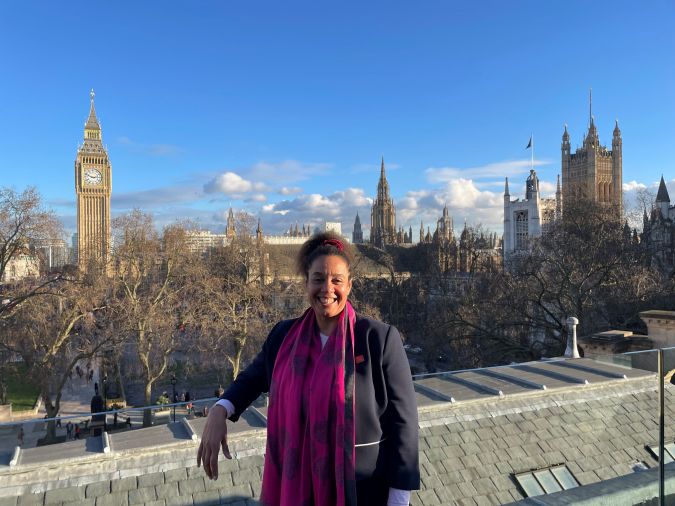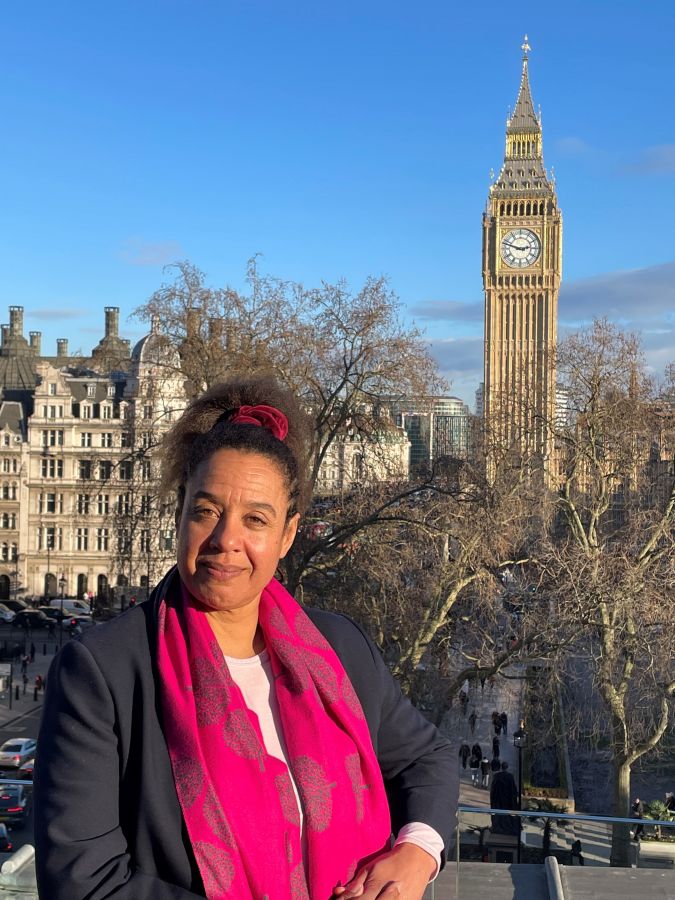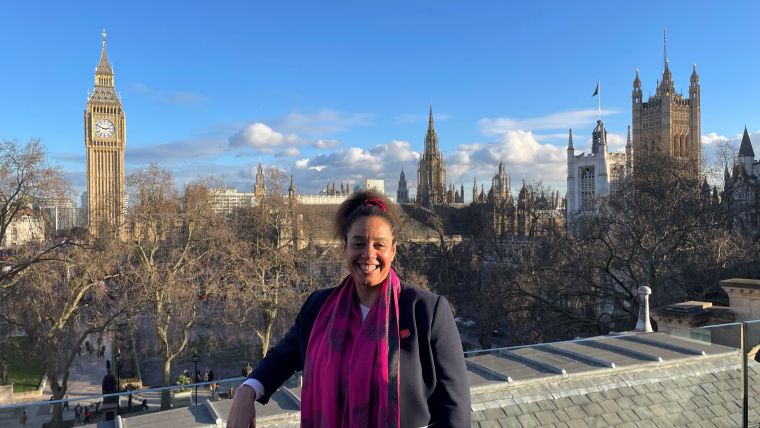Partnerships and people in the surveying community
New FIG president Diane Dumashie reflects on early milestones and looks ahead to the future
Less than six months into her term of office, 'GIM International' spoke to Diane Dumashie, president of FIG (2023-2026), to hear about her experiences so far. Here, she shares her perspectives on a key milestone – the FIG Working Week 2023 in Orlando, USA – and discusses her future intentions as FIG president. She discusses FIG’s plans to build partnerships and joint outputs, the importance of benefiting people and planet, and attracting young talent.
How do you feel when you look back on the first five months of your term as FIG president?
I’m so pleased to have had the opportunity to engage with so many members already. I promised during my campaign that my leadership would include being visible to FIG members and our external stakeholders. This is important as the face of FIG, but it also involves actively listening to enable me to be in the best position to steer and make decisions that affect our organization on a number of levels. I’ve recently returned from the FIG Working Week in Orlando. Those ten days were definitely a pinnacle milestone of my first six months. I’ve regularly been reaching out to presidents of our associations and chairs of our commissions and networks as well as academics, individuals and strategic partners since October 2022, but it was marvellous to meet the FIG community in person in Orlando. To see us all come together with such energy was inspiring. I’ve said many times that it is key to ensure communication, connectivity and collaboration with FIG members and partners. Above all, my message was positively taken on board about underpinning sustainability on all fronts: sustainable people in our profession and sustainable development in our actions – including climate action – will only be achieved by also ensuring sustainable partnerships.
You’ve previously said that the role of FIG is to maintain an influential voice at all levels to continue its beneficial societal impact, and to lead and advocate to raise awareness for its members. How do you intend to contribute to that as president?
A great deal has changed recently, not least the COVID-19 pandemic which I regard as a generationally pivotal episode affecting global society. So what I intend to do in my presidential term is make sure that the FIG membership understands what FIG stands for and how its members are actively collaborating and working together across the world. As the leader of FIG Council and Commission Officers (ACCO), my role is to advocate the good standing of our members as we collectively aim to promote and use professional best practices and standards. As stated in the FIG vision and strategy, ‘Surveyors serving society for the benefit of people, planet and to work in partnership’, we need to be relevant and promote the usefulness of the profession for the public good. As recognized experts in the scope of land administration, land management, geospatial information management and connected surveying and mapping activities, we have a responsibility to respond to this global agenda and to contribute to improving the living conditions in our societies. Over the next four years, I will be supporting FIG – in conjunction with partners – to tackle the global challenges in the land, marine, natural and built environments.
Are there any areas in which you would like to improve FIG’s representation?
Having such a multi-stakeholder approach does come with challenges, not least because there are so many issues that deserve attention. FIG remains open and actively works to be aware, at the very least. But as a federation of volunteers, we need to make careful choices. At the same time, it is important for me to strive to be as inclusive as possible, both around the world and also across generations. In terms of international inclusiveness, one important outcome of the Working Week in Orlando has been the potential to form an Americas Regional Capacity Development Network. This was the direct result of active deliberations led by FIG and a collaborative spirit with FIG member countries in the region, including the Latin American Regional Association, collectively known as APPAT. The network will be modelled on existing FIG networks in the Africa and Asia-Pacific regions. As an example of generational inclusiveness, one of FIG’s strategic objectives is to get better at promoting and encouraging the younger generation into our profession. Last year, I was introduced to a network called the Youth Initiative for Land in Africa (Yilaa), which is making remarkable efforts in land governance and civic society outreach. I am so impressed that I have linked them to FIG’s upcoming Diversity and Inclusion taskforce to effectively collaborate and leverage our mutually respective objectives.
What is your relationship with other fora such as the World Bank and UN-GGIM?
We have many global and regional partners. In the context of all of them, sustainability is about making sure that both internal and external partnerships are working effectively and cultivating stronger engagement for the good of all. Both the World Bank and UN-GGIM are specifically about that too. We very much value our collaboration with both of them and I am keen to ensure that this continues. FIG has been active within UN-GGIM for a long time both on a general basis and also at a workgroup expert level. Much work has been done, but I feel we could be better at being more visible. After all, wherever you look, there is evidence that collecting and interpreting geospatial data is building the world around us. Interestingly, in Orlando we discussed the responsibility this brings if we wish to serve both ‘people’ and ‘planet’. In my view, geospatial information is so obviously a fundamental to our work, as it impacts land management, land administration, agriculture, biodiversity and climate. Similarly, our relationship with the World Bank goes back a very long way but I plan to actively step up our relationship. Going forward, the Council Work Plan is to build partnerships and joint outputs through FIG commissions and networks.

How are your goals for the 2023-2026 term aligned with the Sustainable Development Goals?
The key to a sustainable profession is that we deliver services in a sustainable manner. As a recognized UN NGO, FIG is closely aligned to the UN’s 2030 Agenda for Sustainable Development, which is currently very much driven by a need to act now to address the climate issues, and we have an ongoing taskforce for the agenda. FIG’s Work Plan 2023-2026 is a work plan for people and the planet. It can be seen on a series of levels. The first overarching vision is to ‘serve society’. The second level is the action-orientated theme of ‘tackling the global challenges’. Combining these provides us with a focus on people and planet in the nexus of land and natural resources. These two levels underscore that our profession operates at the global level and practises at the local level. We are a bridge able to articulate between the policymakers and society.
Under this is the level that ensures we navigate this agenda, i.e. the sustainability aims which each form the core of our plan. The five key dimensions at the heart of the 2030 Agenda – people, planet, partnership, peace and prosperity – provide a foundation for our own approach. They inspire us to think creatively and critically rethink the way we approach the development challenges of today. So you can see that sustainability acts like a glue to bind together all of our aims and objectives; it is a golden thread of a sustainable approach throughout. We contribute to sustainable development and respond to the climate agenda by reaching out under four broad aims, with objectives that can influence to build the capacity and develop standards, thereby ensuring the professional sustainability of FIG members’ work and contributions. The first three aims draw on the three P’s: people, planet and partnership. The fourth is an inward-focusing aim looking at our own profession and internal governance. Crucially, FIG will execute these aims through its structure of the Council and the ten professional commissions, as well as networks and the Permanent Institutions. However, to operationalize and leverage the ethos of our aims, we will be guided by the work of Council-appointed taskforces that provide the overarching pillars to unpack our relevance and societal benefit in all four of our broad aims.
What do you perceive to be the most threatening development for the sector, and how can it be tackled?
During my presentation in Orlando, I quoted JF Kennedy who said “Beware of the danger, but recognize the opportunity”. For me, this sums up the important nuance between ‘threats’ and ‘challenges’. Professionals need to be forward-looking and proactive in order to remain relevant, including to society. That’s why FIG’s action-orientated approach has a theme of ‘Tackling the global challenges’. But in terms of the most threatening risks, I would start by understanding the global megatrends affecting societies. I particularly like the list by Professor Gratton, who states a subtle combination of five forces: the needs of a low carbon economy, rapid advances in technology, increasing globalization, profound changes in longevity and demography, and important societal changes. In terms of the sphere of influence of our profession, and therefore FIG, one key role in tackling these is bridging the gap between high-level strategy and policy on the one hand, and the actions on the ground that contribute to sustainable development on the other. If, as a profession, we think and act with agility, we are well-placed to clearly articulate how to deliver meaningful actions around the world. Professions across the work spectrum face the internal threat of not evolving and consequently of not being of benefit to society. To continue to provide leadership in society, we must be ready to innovate, to adapt and to lead the response to change. To remain impactful over the coming decades, all of our members’ work will be shaped by the major global forces affecting societies. Firstly, in this context, one key objective in the FIG Council Work Plan is to set up a task force on the role of FIG in international trends and future geospatial information ecosystems, ensuring it looks at the relevance of FIG members and their professional practice. Secondly, we are striving to match thought leadership with professional practice. At the Working Week in Orlando, for example, FIG and the USA LOC invited a country-national plenary speaker to share knowledge relating to ‘the new frontiers of space and the surveyor’. And a third action is the ongoing partnership FIG has with UNOOSA (United Nations Office for Outer Space Affairs, Ed.), thanks largely to the ongoing efforts of Commission 5.
In an interview in GIM International in 2022, you acknowledged the need to attract and develop people with the right talent and skills to fulfil the ambassadorial, collaborative and engaging leadership roles of the future. What will you do to achieve that?
The Work Plan includes a number of actions that focus on our own people: our members. We must all continue to develop and grow to ensure that we – both as individuals and as a federation of members – remain relevant and capable of delivering on our strategy, at the same time as making sure no one is left behind. To achieve that, we will continue to support the work of the ten technical commissions, who are at the very heart of FIG activities, and promote professional development by providing a global forum for discussion and exchange, both at our annual conferences and through the working groups and seminars of our commissions.
What about attracting young people to the profession?
I believe it is very important to raise the visibility of young people in the surveying profession. The FIG Council will facilitate the voice of young surveyors across all of FIG’s structures. As a start, I invited a young surveyor to be on the Council as a permanent representative, in addition to nominating a young surveyor to co-chair a Climate Compass Task Force that was established at the 46th General Assembly in parallel with the Working Week in Orlando.
In today’s deglobalizing world full of tensions, how do you see the future of FIG as a global, learned society?
I wholeheartedly believe that FIG delivers thought leadership as well as tackling the challenges facing society. Our leadership in new knowledge-making is global, and our professional practice is local. However, the work of all of our members will be shaped by the major global forces affecting societies. These include climate action, rapid urbanization, environmental and resource stewardship, the technology revolution and profound changes in longevity and demography. To continue to provide leadership in society and remain impactful over the coming decades, we must be ready to innovate, to adapt and to lead the response to change.
Which specific skills will be crucial for that?
As president of FIG, my aim is to lead our family of professionals in the land, marine, built and natural environments to collectively help our profession to step up and ensure we remain relevant and resolute. This means we will all need to demonstrate clarity and collaboration, which calls for a listening-and-action approach. Besides that, we will need purpose and reliability, visibility and courage. Above all, it comes down to working together to deliver. This will require the better and greater application of soft skills, not only including leadership and organizational management, but also empathy so that we excel at being ‘stakeholder-smart’.
About Diane Dumashie
Dr Diane A. Dumashie, FRICS, CEDR, has been president of the International Federation of Surveyors (FIG) since the start of 2023, having held several senior officer positions in FIG over the past 20 years. These included FIG vice president, FIG Commission chair, FIG Task Force chair, and founder and chair of the FIG Africa Regional Capacity Development Network. Dumashie holds a doctorate in Land Policy Planning & Integrated Coastal Area Management, and a BSc in Land & Property Management. She is a Fellow of the Royal Institution of Chartered Surveyors and an accredited member of the Centre for Effective Dispute Resolution (CEDR). She is also Trustee Board member of the Lionheart Benevolent charity serving chartered surveyors.


Value staying current with geomatics?
Stay on the map with our expertly curated newsletters.
We provide educational insights, industry updates, and inspiring stories to help you learn, grow, and reach your full potential in your field. Don't miss out - subscribe today and ensure you're always informed, educated, and inspired.
Choose your newsletter(s)
























